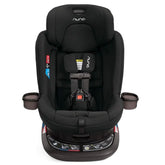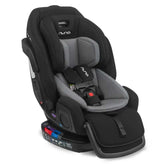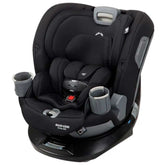How to Choose the Right Baby Gate & Install It Safely

Safety gates, commonly referred to as baby gates, are essential tools for parents and caregivers who want to create a safe environment for their children. These barriers prevent babies and toddlers from accessing potentially dangerous areas, such as stairs and kitchens. With a wide range of baby gates available on the market, it can be challenging to choose the right one. This ANB Baby guide explores various types of baby gates, how to install them safely, and provides alternatives for situations where traditional gates may not be suitable.
Types of Baby Gates
Hardware-Mounted Gates: The Best Baby Gates for Top of Stairs
When it comes to stairs, the best option is a hardware-mounted gate. These gates are bolted or screwed into the door frame or the wall framing, providing the most secure barrier to prevent falls. They are typically made of wood, enamel-coated steel, or aluminum tubing and often have a gate or panel that swings open for easy passage.
- Advantages: Hardware-mounted gates are the most secure and stable, making them ideal for use at the top of stairs. They cannot be easily dislodged by a child pushing against them.
- Installation: These gates require drilling into walls or banisters, ensuring they are firmly anchored. Avoid mounting them into drywall or plaster alone, as this does not provide sufficient support.

Pressure Mounted Baby Gates: Portable Options for Travel
Pressure-mounted gates stay in place by pressing on opposing walls, eliminating the need for installing hardware or drilling holes. They fit openings between 26 and 38 inches, with wider models available up to 62 inches. However, they are not secure enough to be used at the top of the stairs. They should only be used where falling isn’t a hazard, such as between rooms or at the bottom of stairs.
- Benefits: Retractable gates are ideal for areas where a traditional gate might be cumbersome. They are also less obtrusive and can be neatly stowed away when not needed. Having a portable pressure-mounted gate or two is a handy way to make a hotel room or a relative’s home safer for your young child.
- Considerations: Ensure that the retractable gate is properly installed and that the latch mechanism is out of reach of children. Retractable gates should be used where the risk of a child falling is minimal, as they may not be as sturdy as other types of gates.

Hybrid Safety Gates: Combining Features
Hybrid gates combine pressure-mounted systems with optional screws and brackets for added security. Without the brackets, they perform similarly to pressure-mounted gates but offer enhanced stability when the brackets are used.
Baby Gates with Door: Convenient for High Traffic Areas
Baby gates with a door feature a convenient swing-open mechanism, allowing adults to pass through without having to remove the entire gate. This design is particularly useful for high-traffic areas where frequent access is needed.
- Advantages: The door feature reduces the inconvenience of stepping over the gate or uninstalling it each time you need to pass through. It also minimizes the risk of tripping, which can be a hazard with traditional gates.
- Installation: Ensure the door gate is securely mounted using pressure or hardware mounts to prevent it from becoming a tripping hazard or being easily pushed over by a child.

Retractable Baby Gates: Versatile and Convenient
Retractable baby gates are ideal for closing off odd-sized areas or hallways where a swinging gate might not fit. Many parents prefer retractable mesh gates for larger doorways or openings to create a safe space for their children.
These gates are especially useful for children who might wander out of their rooms at night. Placing a retractable gate outside the nursery door helps keep your child safe when transitioning from a crib to a bed. The gate can be closed at night and opened during the day, providing an unobstructed passageway.
Retractable gates are versatile and can be used both indoors and outdoors. They usually require hardware installation, with side hooks that latch onto brackets. A push-and-turn lock keeps the latches secure, allowing for easy one-handed opening.

Play Yards as Alternatives
Play yards are self-standing barriers that can serve as a recreational play area or be installed as a traditional safety gate.
- Advantages: Play yards provide a safe, contained space for your child to play and can be a flexible alternative to fixed baby gates. They can be used both indoors and outdoors, offering versatility.
- Considerations: Ensure that the play yard is sturdy and stable, with no gaps that a child could crawl through or get stuck in.

Installation and Safety Tips for Baby Gates
Choosing a Certified Gate
Whichever style you choose, look for a gate that’s certified by the Juvenile Products Manufacturers Association (JPMA). JPMA-certified child safety gates meet international voluntary safety standards, ensuring they have passed rigorous tests for component strength, latch integrity, and the size of openings to prevent head, finger, or toe entrapment.
Installation Flexibility
Many gates can be mounted to odd areas, such as stair balusters, angled banisters, and drywall without wood framing. You might have to purchase an installation kit for these areas. Some gates also adjust to fit irregularly shaped areas or very wide openings.
Safety Gate Features
- Height: The gate should be at least 22 inches tall and meet the JPMA height standard. The distance between the bottom of the gate and the floor should be less than 3 inches.
- Construction: Choose a gate with a straight top edge and closely spaced, rigid vertical slats or a fine mesh screen. Ensure wood gates are sturdy with smooth, splinter-free surfaces.
- Slat Spacing: Vertical slats or bars should be less than 3 inches apart to prevent head entrapment.
- Latches and Hardware: Look for gates with dual-action latches or pressure-release handles that are easy for adults to use but difficult for children.
- Latch Indicators: Some gates click to signal that they’re latched, while others offer color indicators or alarms.

FAQs About Baby Gate Safety and Installation
How High Off the Ground Can a Baby Gate Be?
A baby gate should be installed with the bottom no more than three inches off the ground. This prevents children from crawling underneath the gate. The gate should be at least 22 inches tall, with many experts recommending a height that is three-quarters of the child’s height to discourage climbing.
Can You Use Baby Gates for Stairs Without Drilling?
No. For the top of the stairs, the US Consumer Product Safety Commission says caregivers should only use gates that screw to the wall. Pressure-mounted gates aren’t secure enough to use at the top of stairs and should never be used that way, no matter how much you want to avoid drilling holes into your walls.
Do Pressure Baby Gates Work?
Pressure-mounted gates are effective when used correctly and in appropriate locations. They are suitable for doorways and at the bottom of stairs but should never be used at the top of stairs due to the risk of dislodgement. For added security, look for pressure gates with additional locking mechanisms.
Can I Use a Dog Gate as a Baby Gate?
While dog gates and baby gates are often similar in design, they are not always interchangeable. Baby gates are tested to higher safety standards and are designed with child safety in mind. Dog gates may not have the same features, such as a childproof locking mechanism or a safe height to prevent climbing. It is best to use a gate designed specifically for children to ensure their safety.
What Can I Use Instead of a Baby Gate?
In certain situations, alternatives to traditional baby gates may be necessary:
- Playpens: Portable playpens can create a safe play area for a child, keeping them contained in one spot.
- Furniture Arrangement: Rearranging furniture to block access to hazardous areas can be a temporary solution.
- Supervision: In some cases, increased supervision may be the best alternative. Ensure that a responsible adult is always nearby to monitor the child.

Creating a Safe Haven for Your Little Explorer
Choosing and installing the right baby gate is crucial for ensuring your child's safety at home. Whether you need a gate for the top of the stairs, a retractable option, or a gate with a door for easy access, there are plenty of choices available to suit your needs. Always follow the manufacturer’s installation instructions and regularly check the gate’s stability. If traditional gates are not an option, consider alternatives like playpens or strategic furniture placement. By taking these steps, you can create a safe environment where your child can explore and play without unnecessary risks. For a wide selection of baby and toddler safety supplies, visit ANB Baby.










